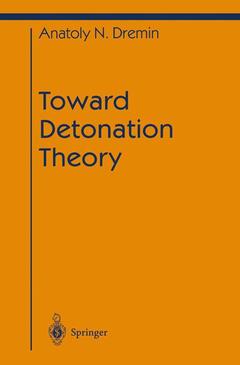Toward Detonation Theory, Softcover reprint of the original 1st ed. 1999 Shock Wave and High Pressure Phenomena Series
Langue : Anglais
Auteur : Dremin Anatoly N.

It is known that the Chapman-Jouguet theory of detonation is based on the assumption of an instantaneous and complete transformation of explosives into detonation products in the wave front. Therefore, one should not expect from the theory any interpretations of the detonation limits, such as shock initiation of det onation and kinetic instability and propagation (failure diameter). The Zeldovich-Von Neuman-Doring (ZND) theory of detonation appeared, in fact, as a response to the need for a theory capable of interpreting such limits, and the ZND detonation theory gave qualitative interpretations to the detonation limits. These interpretations were based essentially on the theoretical notion that the mechanism of explosives transformation at detonation is a combustion of a layer of finite thickness of shock-compressed explosive behind the wave shock front with the velocity of the front. However, some experimental findings turned out to be inconsistent with the the ory. A very small change of homogeneous (liquid) explosives detonation velocity with explosive charge diameter near the rather sizable failure diameter is one of the findings. The elucidation of the nature of this finding has led to the discovery of a new phenomenon. This phenomenon has come to be known as the breakdown (BD) of the explosive self-ignition behind the front of shock waves under the effect of rarefaction waves.
1 Advantages and Limitations of Chapman—Jouguet and Zeldovich—Von Neumann—Döring Detonation Physical Models.- 1.1 Introduction.- 1.2 Chapman—Jouguet Detonation.- 1.3 Zeldovich—Von Neumann—Döring Detonation.- 1.4 Breakdown Phenomenon.- 2 Shock Initiation of Detonation and Breakdown Phenomena.- 2.1 Introduction.- 2.2 Liquid Explosives Shock-to-Detonation Transition Process and Breakdown Phenomena.- 2.3 On Shock Initiation of Detonation in Solid Explosives.- 3 Detonation Kinetic Instability and Breakdown Phenomena.- 3.1 Introduction.- 3.2 Mechanism of Instability Origin.- 3.3 Mechanism of Unstable Detonation Front Inhomogeneity Control.- 3.4 Structure of a Highly Unstable Detonation Front.- 3.5 Unstable-to-Stable Detonation Transition.- 3.6 Comparison of Pulsating and One-Dimensional Models of Detonation Front.- 3.7 The Nature of Spinning and Galloping Detonations.- 4 Failure Diameter and Breakdown Phenomena.- 4.1 Introduction.- 4.2 Failure Diameter of Detonation of Liquid Explosives.- 4.3 Failure Diameter of Detonation of Condensed Heterogeneous Explosives.- 4.4 Conclusions.- 5 On Shock Wave Chemistry of Molecular Condensed Explosives.- 5.1 Introduction.- 5.2 Results and Discussion.- 5.3 Conclusions.- 6 General Conclusion.- References.
Date de parution : 10-2012
Ouvrage de 156 p.
15.5x23.5 cm
Date de parution : 06-1999
Ouvrage de 156 p.
15.5x23.5 cm
Thème de Toward Detonation Theory :
Mots-clés :
instability; mechanics; modeling; shock wave; solid; stability
© 2024 LAVOISIER S.A.S.



